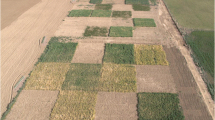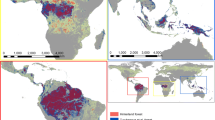ABSTRACT
Because model predictions at continental and global scales are necessarily based on broad characterizations of vegetation, soils, and climate, estimates of carbon stocks and fluxes made by global terrestrial biosphere models may not be accurate for every region. At the regional scale, we suggest that attention can be focused more clearly on understanding the relative strengths of predicted net primary productivity (NPP) limitation by energy, water, and nutrients. We evaluate the sources of variability among model predictions of NPP with a regional-scale comparison between estimates made by PnET-II (a forest ecosystem process model previously applied to the northeastern region) and TEM 4.0 (a terrestrial biosphere model typically applied to the globe) for the northeastern US. When the same climate, vegetation, and soil data sets were used to drive both models, regional average NPP predictions made by PnET-II and TEM were remarkably similar, and at the biome level, model predictions agreed fairly well with NPP estimates developed from field measurements. However, TEM 4.0 predictions were more sensitive to regional variations in temperature as a result of feedbacks between temperature and belowground N availability. In PnET-II, the direct link between transpiration and photosynthesis caused substantial water stress in hardwood and pine forest types with increases in solar radiation; predicted water stress was relieved substantially when soil water holding capacity (WHC) was increased. Increasing soil WHC had little effect on TEM 4.0 predictions because soil water storage was already sufficient to meet plant demand with baseline WHC values, and because predicted N availability under baseline conditions in this region was not limited by water. Because NPP predictions were closely keyed to forest cover type, the relative coverage of low- versus high-productivity forests at both fine and coarse resolutions was an important determinant of regional NPP predictions. Therefore, changes in grid cell size and differences in the methods used to aggregate from fine to coarse resolution were important to NPP predictions insofar as they changed the relative proportions of forest cover. We suggest that because the small patches of high-elevation spruce-fir forest in this region are substantially less productive than forests in the remainder of the region, more accurate NPP predictions will result if models applied to this region use land cover input data sets that retain as much fine-resolution forest type variability as possible. The differences among model responses to variations in climate and soil WHC data sets suggest that the models will respond quite differently to scenarios of future climate. A better understanding of the dynamic interactions between water stress, N availability, and forest productivity in this region will enable models to make more accurate predictions of future carbon stocks and fluxes.
Similar content being viewed by others
Author information
Authors and Affiliations
Additional information
Received 19 June 1998; accepted 25 June 1999.
Rights and permissions
About this article
Cite this article
Jenkins, J., Kicklighter, D., Ollinger, S. et al. Sources of Variability in Net Primary Production Predictions at a Regional Scale: A Comparison Using PnET-II and TEM 4.0 in Northeastern US Forests. Ecosystems 2, 555–570 (1999). https://doi.org/10.1007/s100219900102
Issue Date:
DOI: https://doi.org/10.1007/s100219900102




